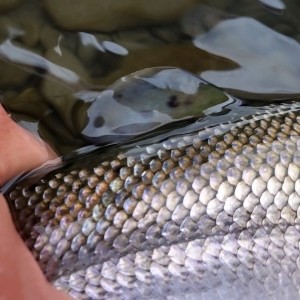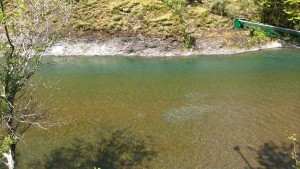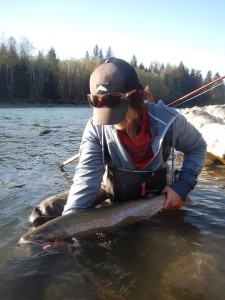
Conservation is a vital aspect of our business. If we don’t thoughtfully manage the ways we fish then our business will be very short lived. However, conservation is more than a means to an end. We are in this field because we love fishing and all of the things that go with it. Even if it means less business because of our convictions then so be it, but we will always put the well-being of the fish and their habitats first. Organizations like the WSC and TU are making great strides on the political side of the conservation efforts, but there are also easy things that each angler could and should do on any day out on the water. Some basic things you can do to help protect fisheries:
1. Be informed. The most harmful people are usually the ones that simply don’t know better. A good place to start is checking out Trout Unlimited, the Wild Steelhead Coalition, or Steelheaders United. There is enough good information from these sources to get some questions answered so one can then form their own opinion and perhaps get involved at wildlife commission meetings or by writing letters to the commissioners.
2. Release ALL wild fish PROPERLY. This is the big one! Catching a wild fish can be one of the most rewarding feelings in fishing, especially when it comes to steelhead. Wild steelhead are notorious for their strength and aerobatics, so on days when luck is on your side and you land a big wild fish the first thing you want to do is take a picture! Can’t blame you there. However, the fish is already very stressed which in itself can be fatal to the fish. Mishandling of the fish, even if not fatal and especially if that fish is unlucky enough to get caught more than once, can and will decrease their spawning success. There are a few things you can do to try and help ensure the fish swims off safely.

An adipose fin means it is most likely wild
a. Quick and proper identification of fish! Wild fish will have a full adipose fin. Some hatchery fish will too, but they usually will have other fin distortions that may or may not be obvious. If you’re not completely sure, release it.
b. Wet your hands before you grab the fish. They have a slimy layer that protects them, and having wet hands will help in preserving that layer. Only grab them by the wrist above the tail. Don’t give a death grip. If they want to bolt, let them. Forget that one picture.
c. Keep fish in its natural, horizontal, upright, position. Their bodies are not made to be held vertically. Gravity will wreck their insides.
d. Keep the fish completely submerged. If you’ve got to have a picture, keep it’s head, gills, and lower body in the water.
e. Give them time to recover. That fish just thought he was going to die. Let him catch his breath. Gently hold them in slow current facing upstream and they will let you know when they are ready to go.
Only a few individual adult steelhead are responsible for producing most of the next generation of steelhead, so keeping, or mishandling just one wild steelhead could have a major impact on an entire population. Let’s not play Russian roulette with our entire fishery for a Facebook profile pic or a single night’s good meal.
3. Consider keeping hatchery fish. Hatchery fish are bred to be consumed. Releasing hatchery fish may actually hurt the wild fish population. They are in competition with each other for food and space, and all the while it increases predators that are drawn to the hatchery holes.
4. Carry a thermometer and stop fishing at 68 degrees. Fish don’t like the heat, and not the same way that fat aunt Mel doesn’t like heat. Fish die when they are too hot and stressed… So maybe it is like fat aunt Mel, but let the fish live. Call it a day when the water gets too hot.
5. Pinch your barbs. Pinching barbs is good for you too! It’ a whole lot easier removing a hook from the back of your head if it doesn’t have a barb. It’s also easier to remove it from a fish. When played properly, most lost fish are not due to the barbless hook.
6. Leave the little guys alone. Give them every possible opportunity to grow into big guys. It’s crazy how big of a meal those juveniles will try to eat, but if you see you’ve got a little guy, try and let him free himself. If you keep catching little guys, move.The juveniles are the future. Do not target them when trout fishing.

A redd on the Elwha River
7. Watch out for redds. A redd is a spawning nest, and can be identified by lighter colored areas in the gravel. They can be hard to see when you’re wading, but really make an effort. Stepping on or near a read can be fatal to the fish-to-be. The eggs are actually deposited slightly behind the big clearing you’ll see, so if you have to be in the water around the redd, realize that walking just downstream of the light colored section is NOT a good idea! If you’re going above the redd, try to not disturb any rocks or pebbles that will end up smashing the eggs.
8. Pick up one piece of trash every time you’re out. (don’t litter either) It’s sickening how much trash ends up in the river! Even more amazing is how many people will say something and just keep walking. It doesn’t have to be any one individual’s sole responsibility to clean up an entire river, but just pick up one piece of trash when you’re out. Maybe two if you’ve got the room. Going out once a year with an empty backpack and exploring some new holes and while picking up some trash will surely bring good fishing mojo.
9. Challenge yourself. If you’re catching lots of fish every single time you go out, maybe try to challenge yourself. Try a different technique that’s less effective. It’s incredibly rewarding to learn a new skill and a different way of approaching your favorite river.
Additionally, there are so many great groups out there working towards restoring and conserving the places that we hold so dear. We greatly appreciate what they are doing and would highly recommend you becoming more informed by getting more involved or becoming a member:
- Wild Steelhead Coalition
- Trout Unlimited
- Wild Steelhead
- United Native Fish Society
- Wild Fish Conservancy
- Hoh River Trust
- SOS Washington
- Wildlife and Recreation Coalition
Elwha Restoration:
Just outside of Port Angeles to the west is the mighty Elwha River, now free of both of the dams that have kept steelhead and salmon confined to 5 miles of river for about 100 years. Still closed to all fishing until at least 2017, the Elwha was our best and most productive trout fishery. The river at one time produced king salmon up to 100 lbs and whether we will ever see them that big again is hard to imagine, but also very hard to predict. Salmon and steelhead are returning to the river and are going up above the former dam sites in pretty good numbers. They know what to do and the potential for recovery is huge. The river is already showing real promise and the future is bright for the Elwha valley.

